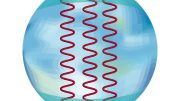
The blue glow at the center of a research reactor at Oak Ridge National Laboratory. The glow is created by electrons emitted in radioactive decays in the radioactive core. Credit: Image courtesy of Oak Ridge National Laboratory, U.S. Dept. of Energy; photographer Genevieve Martin
What Is Radioactivity?
Radioactivity is the release of energy from the decay of the nuclei of certain kinds of atoms and isotopes. Atomic nuclei consist of protons and neutrons bound together in tiny bundles at the center of atoms. Radioactive nuclei are nuclei that are unstable and that decay by emitting energetic particles such as photons, electrons, neutrinos, protons, neutrons, or alphas (two protons and two neutrons bound together). Some of these particles are known as ionizing particles. These are particles with enough energy to knock electrons off atoms or molecules. The degree of radioactivity depends on the fraction of unstable nuclei and how frequently those nuclei decay.
The effect of radioactivity also depends on the type and energy of the particles produced during nuclear decay. For example, neutrinos pass constantly through the Earth, while alpha particles are blocked by a sheet of paper. Radioactivity can cause damage in materials and in plant, animal, and human tissue. Scientists and engineers use radioactivity as a source of heat for satellites, medical imaging, targeted cancer treatments, radiometric dating, and research into the laws of nature and the origin of matter.
Radioactivity Facts
- Radioactivity has always been present on Earth, but it was not scientifically studied until 1896.
- The largest source of ionizing radiation for the average American is from naturally occurring radon in the air.
- Without heat from naturally occurring radioactivity, the Earth’s core would have frozen billions of years ago.
DOE Office of Science: Radioactivity Contributions
Since its discovery in 1896 by physicists Henri Becquerel, Pierre Curie, and Marie Curie, radioactivity has provided clues to the laws that govern nature. Today, the DOE Office of Science supports nuclear decay experiments to answer fundamental questions like: Why is there more matter than anti-matter? What is dark matter? And why do neutrinos have such a tiny mass?
Radioactive isotopes are also critical to modern society, with uses in medicine, chemistry, energy, environmental sciences, material sciences, manufacturing, and national security. A goal of the DOE Isotope Program is to support the research and development of methods and technologies to produce isotopes that are in short supply in the United States and reduce our dependence on foreign supplies. For example, the DOE Isotope Program produces actinium-225, which is being investigated for use in cancer treatments, as well as berkelium-249, which was used in the recent discovery of the laboratory-created synthetic element 117.









Be the first to comment on "Science Made Simple: What Is Radioactivity?"